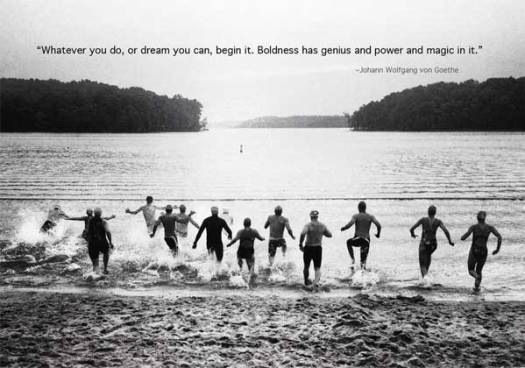Here is a great article written on open water swim safety by my coach, Robbie Bruce. Even though I posted this after my analysis, Robbie’s perspective is the precursor for a lot of my opinions on swimming smart, safe, and fast. He looks at what’s right and what’s wrong with Ironman swims and gives a ton of solid information, including 8 things you can do now to be a better and more confident open water swimmer.
Triathlon Deaths – By Robbie Bruce

Over the past few weeks a lot has been written about in regards to the amount of deaths in triathlon especially in the swim portion. A lot of blame has been cast, towards pretty much everyone, and plenty of solutions have been suggested. The fact is, the blame falls upon us all. This problem will likely never see a 100% turn-around with zero deaths but there are plenty of ways we can improve while still keeping the sport tough. Here is USAT fatality study discussed:
http://www.usatriathlon.org/news/articles/2012/10/102512-medical-panel-report.aspx
Dangerous conditions and temps-
FINA (International Governing Body) came under some scrutiny in 2010 when American’s best open water swimmer Fran Crippen, 26 died during the 10k Marathon Swimming World Cup in the UAE. It was reported the water temp was a balmy 87 degrees with the air temp hovering around 100. Was he equipped to swim and race the distance? More than anyone. But, were the conditions unsafe? FINA has since set minimum and maximum water temp regulations but others have not followed suit.
From the OTD article:
“There is a growing consensus that a warm-up or pre-race water acclimation area can help relieve athlete anxiety, but races are not required to provide one. USA Swimming and FINA, that sport’s international governing body, have set minimum and maximum water temperature regulations for open-water races, but USA Triathlon officials have not.” (There are rules about when wetsuits can be worn.)
Veteran Southern California open-water and triathlon coach Gerry Rodrigues is sharply critical about the absence of water temperature “collars,” and maintains that the sport must protect amateurs in that area.”
“Generally, most triathletes are under-prepared for their triathlon open water swim segment,” he wrote in an email interview with “Outside the Lines.” “Introduce the extreme element of super cold water, coupled with their anxiety from a crowded field race environment, lack of prep, fast race start without warm-up, a tight wetsuit and a predisposed health condition, the formula is now there for increased problems.”
I absolutely agree that both USA Triathlon and WTC should implement a water temperature “collar.” That was my concern for athletes doing Ironman Tahoe. Some water conditions are often deemed too rough and many races have cancelled the swim portion of their event. Don’t get me wrong. I will swim in anything. I am lucky enough to have a background in open water swimming and I prefer it rough in the water. It benefits me from a competitive standpoint but I also understand the risk to the triathlete.
The swim portion of the New Orleans 70.3 race I signed up for in 2012 had its swim cancelled. I was personally bummed but as I ran past the lake on the pre-bike run leg I saw the conditions and thought to myself, “Man. That is some very rough water. I would swim it and have a rough time but I can totally see why they cancelled it today.” I hated it but it made sense. From an Race Director’s perspective, if you have it and then have all of your kayaks assisting swimmer who can’t finish what happens if someone does have an emergency? Who is there to help? The RD is the least favorite person when a race is cut short, but that is the part of their job.
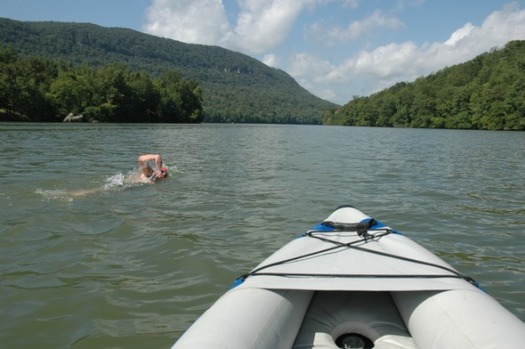
Athlete Preparation-
Gerry is one of the most well regarded experts and coaches when it comes to open water. He has his team based in San Diego, CA called Tower 26 http://tower26.com. Click on the link and the first words you see in big/bold letters “BE RACE READY.”
That is where I believe triathletes set themselves up for, not only lost time in the swim , but potentially lost years off the rest of their life. As often as triathletes are lauded for their dedication and attention to every detail, they are also incredibly lazy when it comes to certain areas. We look for any way to buy “free’ speed. We will spend hundreds or even thousands of dollars on items just to help us “go faster.” The only item you can purchase that covers both safety and speed are those funny looking aero helmets. They cost around 2-300 dollars and we will maybe wear them 4-6x per year.
When it comes to swimming, triathletes have been told for year and years, “The swim doesn’t really matter. Don’t waste your time trying to get much faster. Just try and get through it.” Not only from a training perspective but a preparation perspective these types of attitudes have always rubbed me the wrong way. One of the most alarming quotes from the OTL piece to me is this one:
“A week before the race, they did a test open water swim not far from the triathlon course. They talked with their teammates and coach about how to stay calm if they got bumped or felt panicky in the water.”
In no way am I saying this increased a possibility of death but it did not help. The fact though is that this is much too common among triathletes. “Race is coming up! Let’s go try on a wetsuit and swim an easy 20mins in the lake. That should do it.” It is a lot like people walking into a nutrition store 2 weeks before Spring Break, purchasing a “weight loss” pill and expecting it to help the way they look at the beach. I hate to break it to you. It does not work.
If your race has hills on the bike. You train for hills. If it is going to be hot. You train in the heat. If the race is open water and could be rough you . . . train in the pool. Wrong.
But, that is the widely practiced and expected method of training and it should not be. This responsibility falls on the athlete and the coach. You can’t mentally prepare for the swim start of a triathlon. You must live it and practice it and then . . . you learn to love it. It is less about starting the race faster than your counterparts and more of what it does for your overall comfort in the water. You see more fear on the faces and in the eyes of triathletes as they walk to the swim. It is not the length of the 140.6 miles it is the 2.4 miles that await them in the water. Bottom line- quit over-looking the swim.
Race Directors-
I have never directed a race nor do I have the desire. Being an RD is a lot like being a long-snapper. No one knows your name until something bad happens. During the OTL show the subject of under-trained and prepared volunteers was brought up. This is a dicey area where there is no real answer or solution. Would it be ideal if every single volunteer in the water was open water rescue certified? Yep. Is that practical? Absolutely not.
I think most of you would agree, every time I walk into the YMCA to swim in the pool I look around and think, “If something does happen to me. I am pretty much screwed.” So even requiring a pool certification for in water volunteers would likely be a mute point from a safety/preventative point. In fact, a few weeks ago during a race I was actually leading in the swim and had my own personal kayak following me. I thought “man this is nice but if do have an emergency what is that person going to do to save me? There is no boat around. Good luck getting me in the kayak and to shore.”
There were not enough volunteers or boat safety. Last weekend I stood on the shore at the Goose Pond Triathlon watching some of my athletes swim the 2 loop 1.2 mile swim. It was well supported with 15-20 kayaks and 4 support safety boats. EMS was also parked by the swim exit. That race had maybe 200 participants. Did it seem safer? Yep. Could it have prevented a swim death? We will never know. What is the solution? No idea.
I do believe courses should be available to in water volunteers the day before or even 2 days. They are not handing out water and sponges. They should have to meet a criteria I believe. They have a bit more responsibility to put it lightly.
Governing Bodies-
As I stated before I believe a temperature “collar” should be implemented but it doesn’t need to stop there. World Triathlon Corporation has the “SwimSmart” initiative that includes a minimum of 52 degrees and a maximum of 88. I think the 52 is a bit low, and let’s be honest, they will drop that thermometer 50 times in order to find a 53 so they won’t cancel the swim.
Cancelled swim means lost revenue.
I think access to a pre-race warm up should be available at EVERY event. Especially when the temps are cooler. Stretch cords aren’t going to do it folks and don’t prevent anything. Make it happen. As great and safe as the new “rolling start” sounds there is no correlation to increased deaths because of mass starts.
I actually think the mass start, second only to the time trial start is the safest. You have 1-3 rows in the front going out hard. Most of these are experienced open water swimmers. As the rows go back you have the slower, less experienced swimmers. With multiple “waves” now you have actually increased the number of front row swimmers likely to go out fast or hard. It might reduce the “bumping” and “chaos” but I doubt the anxiety and lowering of your heart rate. Above everything else, just add a pre-race warm up.
What can you do?
– Prepare for the swim like you do the bike and run. It’s simple.
– Go in for routine check-ups with your doctor. We may think we are invincible and our kids may think we are the comic version of Ironman so do yourself and your kids a favor and get your engine checked.
– Bump and Grind. Find as many ways to simulate the roughest start possible. Do that and race day will feel calm.
– Make yourself swim hard and do it often. Most triathletes swim the same speed…all….the….time. Know how that feels. You will be a better swimmer and the first 100-200 meters of the race won’t be a surprise to your aerobic system.
– Choose venues that suit your abilities, experience and confidence.
– Swim in the open water as much as possible. You won’t only learn to hate the pool, you’ll increase you fitness. Ever notice how much harder long course practices are from short course? Go get in the open water. Increased comfort, fitness, and ability will follow.
– Learn to love swimming. If you can do that you will find more ways to prepare appropriately.
– Look at race history and the percentage of cancelled swims. Don’t like it rough. Don’t sign up.
Prepare to swim smart, safe and fast.
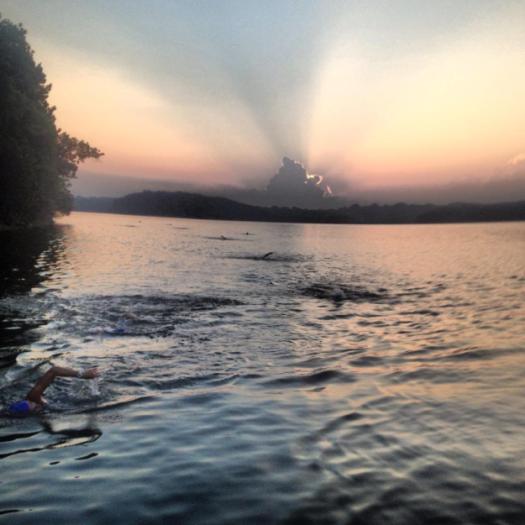







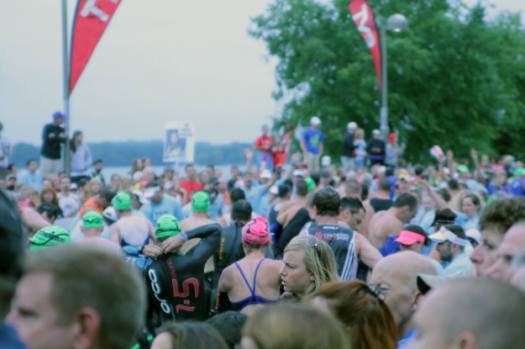
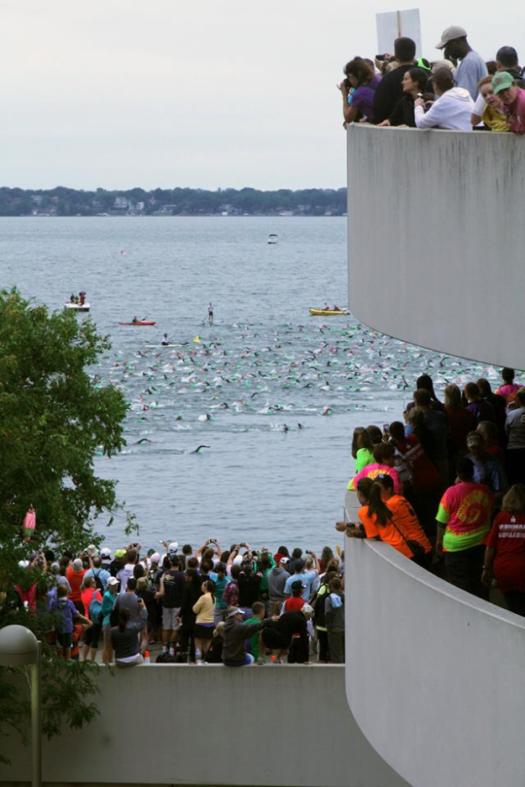 World Triathlon Corporation
World Triathlon Corporation